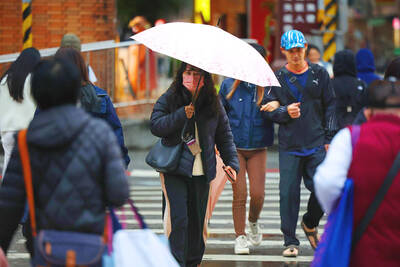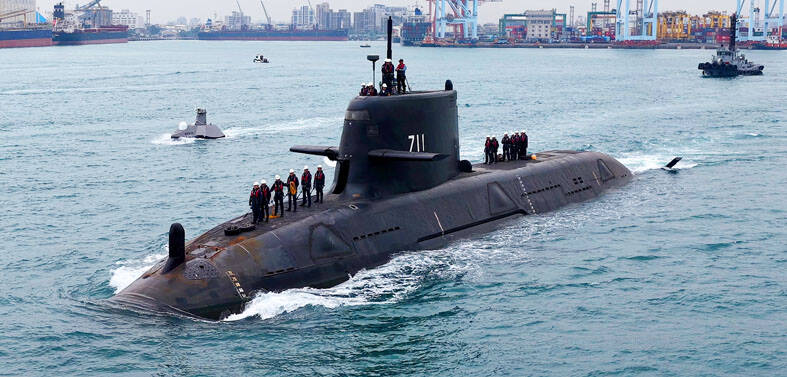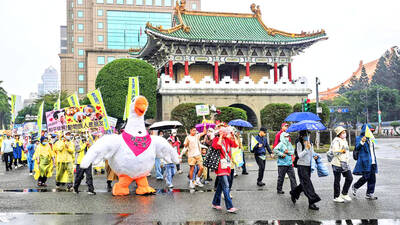US-based Foreign Policy magazine says that Taiwan should “mimic mainland China’s missile program” rather than ask the US to sell it advanced F-16C/D aircraft.
“Mobile launchers, which unlike airfields could evade detection and targeting, could support both -battlefield and strategic missiles that could hold targets on the mainland at risk,” says an article on the magazine’s Web site called “This Week at War: Rumsfeld’s Revenge.”
“Such a program could do a better job of restoring a military balance across the Taiwan Strait than would fixed-wing aircraft operating from vulnerable bases,” said the article by Robert Haddick, who writes a weekly column for the magazine.
Haddrick adds that Taiwan has long been pursuing a variety of indigenous missile types, but that engineers have yet to work all of the bugs out.
“A test last week of a new supersonic anti-ship cruise missile failed to find its target. This followed two more failed tests earlier this year of other missile designs,” he says. “But Taiwan’s struggle to adapt to the immense missile threat from the mainland — over a thousand ballistic missiles are now aimed at Taiwan and a hundred more are added every year — also applies to US military strategy in the region.”
“United States military plans can no more rely on fixed bases and concentrated surface naval forces than Taiwan can. In the meantime, Taiwan could use some missile engineers instead of more F-16s,” he says.
Haddick, managing editor of Small Wars Journal and a former US Marine Corps officer, reports that the administration of US President Barack Obama sold Taiwan a package of exclusively defensive equipment in January last year and that as a result “blew up” the Pentagon’s relationship with Beijing for more than a year.
“An F-16 deal would undoubtedly be even more explosive,” Haddrick’s article says.
It says that both former US president George W Bush and Obama have demurred on Taiwan’s F-16 request “for good reason.” China’s ballistic and cruise missile force is more than capable of crushing Taiwan’s airfields, rendering its fixed-wing air power nearly useless, it says.
“Anticipating this, Taiwan has plans to fly its fighters from highways. But this is no way to generate enough sorties to confront a high-intensity attack from China,” he says. “Fighter aircraft need maintenance, fuel, ordnance and much other support, all of which are efficiently located at modern airbases, not by the side of a highway.”

NUMBERS IMBALANCE: More than 4 million Taiwanese have visited China this year, while only about half a million Chinese have visited here Beijing has yet to respond to Taiwan’s requests for negotiation over matters related to the recovery of cross-strait tourism, the Tourism Administration said yesterday. Taiwan’s tourism authority issued the statement after Chinese-language daily the China Times reported yesterday that the government’s policy of banning group tours to China does not stop Taiwanese from visiting the country. As of October, more than 4.2 million had traveled to China this year, exceeding last year. Beijing estimated the number of Taiwanese tourists in China could reach 4.5 million this year. By contrast, only 500,000 Chinese tourists are expected in Taiwan, the report said. The report

Temperatures are forecast to drop steadily as a continental cold air mass moves across Taiwan, with some areas also likely to see heavy rainfall, the Central Weather Administration (CWA) said. From today through early tomorrow, a cold air mass would keep temperatures low across central and northern Taiwan, and the eastern half of Taiwan proper, with isolated brief showers forecast along Keelung’s north coast, Taipei and New Taipei City’s mountainous areas and eastern Taiwan, it said. Lows of 11°C to 15°C are forecast in central and northern Taiwan, Yilan County, and the outlying Kinmen and Lienchiang (Matsu) counties, and 14°C to 17°C

STEERING FAILURE: The first boat of its class is experiencing teething issues as it readies for acceptance by the navy, according to a recent story about rudder failure The Hai Kun (海鯤), the nation’s first locally built submarine, allegedly suffered a total failure of stern hydraulic systems during the second round of sea acceptance trials on June 26, and sailors were forced to manually operate the X-rudder to turn the submarine and return to port, news Web site Mirror Daily reported yesterday. The report said that tugboats following the Hai Kun assisted the submarine in avoiding collisions with other ships due to the X-rudder malfunctioning. At the time of the report, the submarine had completed its trials and was scheduled to begin diving and surfacing tests in shallow areas. The X-rudder,

DEMAND: The government should enact regulations in line with Austria and Germany to incorporate vegan nutrition into school meals, an advocate said More than 1,000 people yesterday marched in Taipei to promote veganism, calling for legislation to incorporate vegan diets into school lunches and the national net zero emissions program. Participants gathered on Ketagalan Boulevard in front of the Presidential Office Building for the march, which was organized by the Vegan Action Network (VAN). Former ambassador to Chad Chiu Chung-jen (邱仲仁), actor Yankee Yang (楊子儀) and actress Cindy Lien (連俞涵) attended the event. VAN member Marianne Chao (趙梅君) said that the campaign aimed to urge the government to promote vegan diets across schools and government agencies via legislation and national policies, which would help build